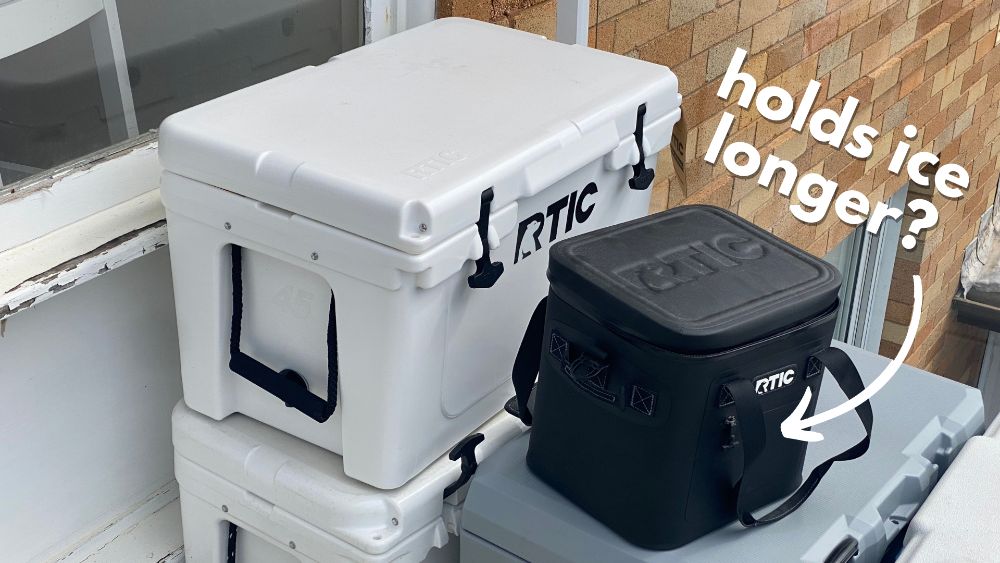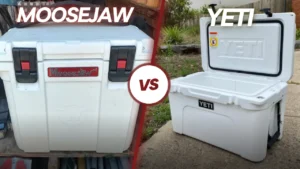Have you ever noticed that your mini cooler filled with ice will still have solid blocks by the end of the day, yet you can put the same bag of ice in a bigger cooler and at the end of the day it's filled with more water than ice?
I have, and I decided to do a little digging. Here’s what I found and how to fix this problem.
Bigger coolers do keep ice longer than smaller coolers but only if they have more ice/frozen items. The increased cold thermal mass helps everything stay cold longer. Smaller coolers outperform larger coolers when only a small amount of ice is use. The extra empty air space in the larger cooler causes the ice to melt faster.
In this article, I will explain if bigger coolers do keep ice longer than small ones and why the bigger coolers can only sometimes keep ice longer.
After reading this article you'll know exactly how to keep ice longer in your cooler no matter what size it is.
Do Bigger Coolers Keep Ice Longer? Why?
When I did all my research for the best coolers for ice retention I found that consistently larger coolers will outperform smaller coolers in most ice tests. However, there are some ice tests where the smaller coolers actually do better.
Below you can see an ice test with Kong Coolers (the #1 best cooler for ice retention) and the results are completely based off size:
- 6 Days 8 Hours – Kong Cooler 25-Quart
- 8 Days 12 Hours – Kong Cooler 50-Quart
- 9 Days – Kong Cooler 70-Quart
- 10 Days – Kong Cooler 110-Quart
This test clearly shows that the bigger the cooler the longer it will hold ice.
Right?
Well check out this ice test challenge below where 20 lbs of ice is placed in each cooler regardless of size and then ice retention is tested:
- 2.0 Days: Siberian 80-Quart
- 2.5 Days: Pelican 55-Quart Tailgate
- 3.0 Days: Siberian 40-Quart
- 3.0 Days: Blackrock 52-Quart
- 3.0 Days: K2 Summit 50-Quart
- 3.0 Days: Grizzly 40-Quart Tan
- 3.0 Days: Orca 58-Quart
- 3.5 Days: Orion 45-Quart
- 3.5 Days: Pelican ProGear 45-Quart
- 3.5 Days: Igloo Sportsman 40-Quart
- 3.5 Days: Eddy Gear 52-Quart
- 3.5 Days: Engel 50-Quart
- 3.5 Days: Grizzly 40-Quart
- 3.5 Days: Canyon 35-Quart
- 4 Days: Yeti Tundra 45 (37-Quart)
- 4.0 Days: Engel 25-Quart
- 4.0+ Days: Grizzly 20-Quart
Notice a clear trend here with the larger coolers having the ice melt significantly faster and the smallest cooler of the lot (the Grizzly 20-Quart cooler) lasting longer than any large cooler?
What gives?
There are 3 major factors in play here:

- Total volume of ice (thermal mass)
- Total air space within the cooler
- Total surface area of the cooler
The answer to this question all depends on the amount of ice in the cooler (amount of thermal mass that needs to be heated) and the ratio of ice to space.
When you fill a cooler to the brim with ice, you are adding A LOT more thermal mass. Just like how it takes longer to warm up a swimming pool than it does a small cup of water it takes longer for the heat from outside to warm up and melt a lot of ice vs a small amount of ice.
So large coolers, when full, contain significantly more thermal mass than smaller coolers.
Also when a cooler is full it effectively leaves no room for any warm air to sit in the cooler. The same logic can be applied to a small or even a mini cooler that is filled with ice.
When both big and small coolers are completely filled with ice – it is the difference in the amount of ice and thermal mass that causes the large coolers to perform so much better than the small coolers.
When larger coolers are filled with ice, they have a lot more ice than a small cooler; therefore, their thermal mass is bigger. Unlike small coolers that have a smaller thermal mass, it will take more energy to melt the larger thermal mass than the smaller thermal mass.
However, when you use the same amount of ice in each cooler the internal thermal mass is the same, but the empty air space as well as the surface area of the cooler is much larger in big coolers vs small coolers.
More surface area means more area for heat to get in from the outside, melting the ice faster and more air inside the cooler means this heat can circulate more freely and melt the ice inside the cooler much faster.
So, what is the verdict?
Bigger coolers will keep ice longer than smaller cooler IF they contain more ice. Smaller coolers will outperform larger coolers if they use the same amount of ice.
Why Do Bigger Coolers Only Sometimes Keep Ice Longer?

We have already concluded that the larger coolers keep ice longer when they contain more ice, but sometimes you may find that your larger cooler is not keeping the ice longer than your mini one.
There are a number of factors that could influence the cooler not to keep ice for as long as you want it.
The Amount and Ratio Of Ice Is Too Low
One of the most common reasons why your larger cooler is not keeping ice longer is because you're not using enough ice and your ice-to-open space ratio is not correct.
Air space is the enemy of ice retention and if you want to keep ice longer in your cooler you want to minimize air space as much as possible.
Because your cooler is so large, you will need to add more ice to fill all the spare air spaces. A simple way of doing this is to make sure that you layer the ice between the contents of the cooler and that the ice is filled all the to the top of the cooler.
The Cooler Surface Area Is Larger
Larger coolers have a bigger exterior and thus more surface area. This means there is a larger area for heat to pass through the foam insulation and into the cooler.
What this means is that overall more heat enters a large cooler than a small cooler. This leads to ice melting faster in a large cooler than a small cooler.
The only reason ice lasts longer in a larger cooler is because there is more ice and thus more thermal mass so it takes more energy (and time) to melt all that extra ice.
Empty Air Space In Your Cooler and Ice That Is Spread Out
If you use a large cooler without filling it to the top there will be a lot of empty air space in the cooler.
Heat can easily circulate through this empty air space and warm up your ice faster.
Given the cooler is bigger the ice cubes will also be spread out more and have a larger overall surface area exposed to this warm air. This will cause the ice to melt faster than if it was tightly bunched together like it would be in a smaller cooler.
How To Keep Ice Longer In Bigger Coolers
There are a number of handy hacks you can use to help your large cooler keep its ice for much longer.
Pre-chill your cooler
Pre-chilling your cooler is essential if you want to keep ice for a long time in your cooler.
While cooler foam insulation is great at keeping out heat over time a cooler can actually absorb a lot of heat into its foam. If you place ice in a warm cooler the heat in the foam insulation will melt the ice quickly.
If ice is melting quickly in your expensive cooler I can almost guarantee this is the reason why.
An easy way to pre-chill your freezer is to add a bag of sacrificial ice the night before you plan on using your cooler. This will cool down the insulation.
Then when it comes time to pack your cooler discard this ice and put fresh ice in your cooler.
Double up on ice
The simplest way to keep your ice cool longer is to double the amount of ice you put in your cooler. You want to make sure that there are no empty spaces for warm air to occupy.
You can do this by creating a layer of ice on the bottom of the cooler, placing your food contents on top of the ice, and covering the sides and top of the food contents with more ice.
When in doubt, add more ice!
Drain the water
Many people think they shouldn't drain the water from the bottom of their cooler and it'll keep things colder longer. Cold water is colder than warm air right?
But interestingly draining the water from your cooler helps ice last longer.
This is due to the fact that water (even cold water) can transfer heat 23.5 times more efficiently than air.
Use block ice
The ice that you use can also influence your cooler's ice retention. I recommend using ice blocks rather than loose ice because they last longer.
While block ice does not cool your contents as quickly, it melts at a slower rate. Ice blocks are easy to make at home in your freezer or you can purchase them from some stores.
Check out my awesome guide on how to make your own DIY ice packs.
Keep Your Ice Cool And Other Helpful Hacks
A large cooler will keep your ice cool for longer if you use enough ice, but you can read my guide on some awesome cooler hacks to keep ice longer.
The way you pack your cooler can also help with ice retention; my guide on packing a cooler better is worth checking out.



